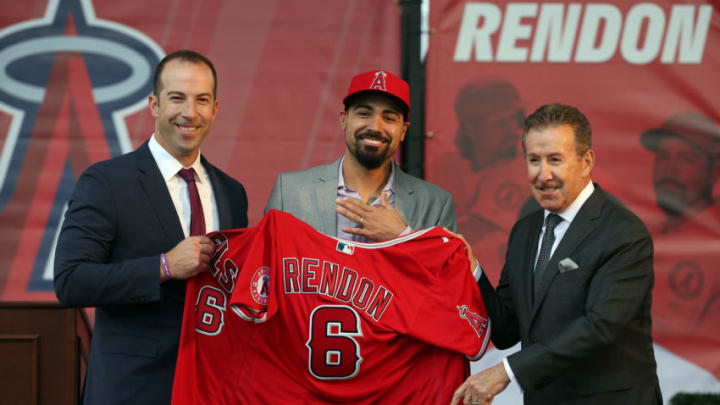Our series of articles looking at the front office structure of each major league team continues as we look at the Los Angeles Angels.
Los Angeles Angels
- Owner: Arturo Moreno
- General Manager: Billy Eppler
Moreno was an outdoor advertising executive when he laid down $184 million to buy the Los Angeles Angels from the Disney Company in 2003.
From an ownership standpoint, the brand is one of the game’s most stable, having had only three owners across 58 seasons of franchise history. Disney Corp. had held the team for just five of those seasons, obtaining it from the estate of original owner Gene Autry in 1999.
That stability has less reliably translated to the front office. During his 16-season tenure, Moreno has filled the team’s general manager position five times, suggesting that he can be a demanding guy to work for.
Bill Stoneman, the GM Moreno inherited from Disney, stepped down following the 2007 season, to be replaced by Tony Reagins. He made it through four seasons before losing a power struggle to field manager Mike Scioscia, and Moreno replaced him with Jerry Dipoto.
But Dipoto lasted only until 2015, when Moreno brought Stoneman back on an interim basis while conducting the search that ultimately identified Eppler. He signed a four-year deal with a team option for 2020, and Moreno’s exercising of option in effect made Eppler the first Moreno GM to win re-election, if only for one season.
Stay tuned for further developments on that front.
Eppler graduated from UConn in 1998 with a degree in finance and an eye toward the sports business. Catching on with the Yankees, he won several internal promotions that eventually took him to a vice presidency under Brian Cashman when Moreno hired him.
The Angels are valued by Forbes at $1.9 billion, sharing the nation’s second largest metropolitan area with the Dodgers. That makes them the game’s eighth most valuable property. Still, although only four years less established than the Dodgers, they are decidedly the area’s second team, a status they have in common with the Mets in New York and White Sox in Chicago.
You can measure that status in market-produced revenue. The Angels pulled $867 million out of their market last year, only a bit better than 50 percent of the $1.617 billion earned from that same source by the Dodgers.
That Angels have from time to time paid dearly for their status as wastrel son. Between Autry and Moreno, the club went through several name re-brandings, beginning as the Los Angeles Angels. In the mid 1960s – having already lost the brand battle to the more successful Dodgers and with its new stadium relocated in Anaheim – Autry renamed his franchise the California Angels in the hope of establishing a regional identity. When Disney purchased the team, it extracted a substantial payment from Anaheim, in return for which the club became the Anaheim Angels.
Shortly after taking ownership, Moreno tried to halve the ownership baby, announcing another rechristening, this time to “Los Angeles Angels of Anaheim.” Nobody bought it – in fact, the city of Anaheim sued to prevent it – and the change was largely ignored, including by MLB.
Still, the lasting perception has been of a franchise without a true physical identification, a problem reflected by that previously referred-to market pull.
Their $348 million 2020 revenue is up 60 percent from the $217 million of a decade ago. Salary demands are, however, heavy when you are competing against the Dodgers, and the Angels have paid dearly, particularly for the headliner names they believe they need to succeed in the vicinity of Hollywood.
The $187 million they spent on player payroll in 2019 – just short of the $188 million team record of two seasons earlier – amounts to about 54 percent of gross revenues, a mid-range percentage. The 12-year, $426.5 million deal Eppler finalized with mega-star Mike Trout will pay Trout $37.7 million in 2020.
Throw in the seven-year, $245 million they just gave Anthony Rendon and the final three seasons of the five-year $128 million they gave Justin Upton and the Angels end up funneling more than 60 percent of their total on-field payroll to just four sluggers.
Still, the Angels generally make money. They counted $19 million in pre-tax operating income in 2019, down from $68 million in 2017 but acceptable compared with the less-recent past. During the DiPoto regency, the club turned an operating loss that hit $12.9 million in 2013, and which had to be a contributing factor to DiPoto’s departure…although the then-fresh Pujols contract also played a role.
At an average of $42 revenue from each paying fan, the Los Angeles Angels are a mid-range bargain, especially when measured against their cross-region rivals, who extract nearly twice as much from their customer base. They are the richest team in the AL West, although not decisively more liquid than either the Astros or Rangers.
Eppler’s ability to maneuver relatively large sums of money has not to date markedly improved the team’s talent base. Based on Wins Above Average*, his various player transactions have influenced the team’s on-field product by an average of -3.0 games per season, labeling him as a net drag on performance.
Inheriting a wild card entry from 2015, Eppler’s tenure has resulted in four consecutive losing seasons with an average winning percentage of .472. Considering that those blue bloods across town have won 60 percent of the time over that same span, it may be surprising that Moreno picked up that option on Eppler’s contract.
*This calculation is obtained by determining the net impact of all player transactions on team performance for the season(s) in question. Wins Above Average is a zero-based offshoot of Wins Above Replacement; thus, the final figure suggests the degree of positive or negative movement in the standings attributable to front office moves.
